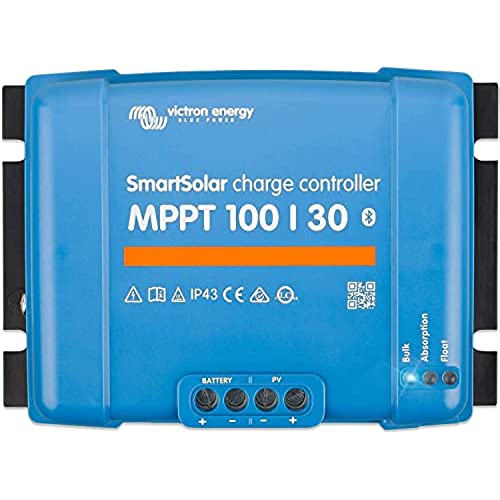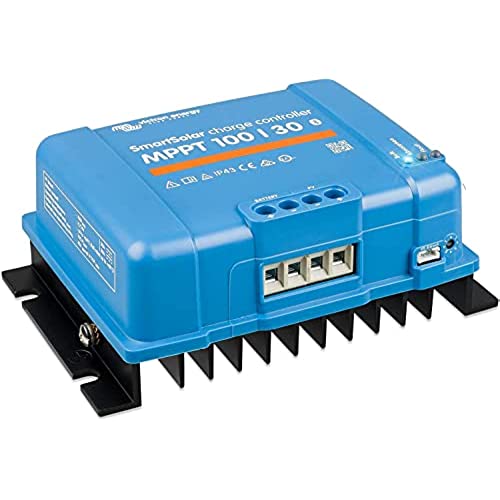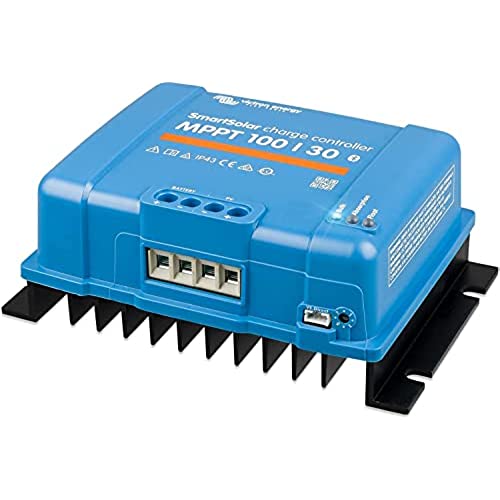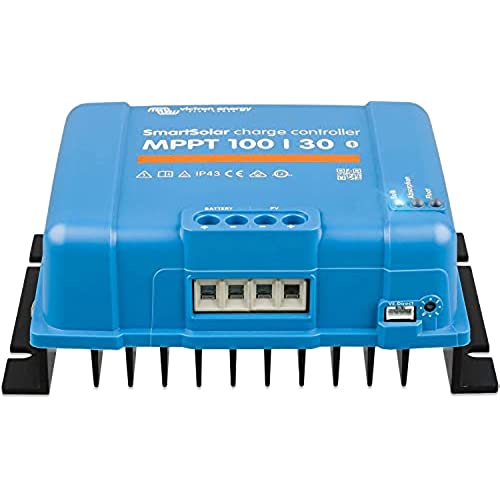









Victron Energy SmartSolar MPPT 100V 30 amp 12/24-Volt Solar Charge Controller (Bluetooth)
-

aTypicalEngineer808
Greater than one weekSummary: I have evaluated quite a few MPPT controllers for Vine, and while all were decent, the Victron Energy (VE) has high ratings, so I decided to purchase one for evaluation. My solar/PV system specs: 1000W of panels; 24-volt, 270Ah marine battery bank (Optima); Voltworks 2000W inverter. Using the system to reduce our electricity bill. This review is for the 100V/50A, which is the 2nd VE controller Ive purchased. Observations: The first thing to notice is that this one, unlike most others, does not have a control panel (just three LEDs); which means youll need a smart device to read the values. There are two basic VE offerings: this SmartSolar (built-in bluetooth), and BlueSolar (requires a BT dongle). Between the two, I went with the built-in BT (SmartSolar). One great feature of the VE system, is that it allows the MPPTs to communicate with each other via BT; which is a great feature for a larger system. Recommendations: One reason to choose the lower cost BlueSolar over the SmartSolar, is if you do not need the additional features that the BT brings; but for me, I didnt mind spending the extra $30-40 (per controller) to gain those features. Pros: Industrial quality & features; good application support (firmware updated upon first connect); security (bluetooth); good/efficient charging algorithm; good data and graphs. Cons: No built-in display (offset by the much better app and graphs). Conclusion: At $325, rating this 5-stars. Of all the MPPT controllers I have reviewed, Victron is the recommended brand. Related Products (lised in ORDER of HIGH to LOW rating): VICTRON ENERGY MPPT 100V 20 amp 12-24-Volt (Bluetooth) ~ $160 (5-star) https://www.amazon.com/gp/product/B075NPQHQK EPEVER MPPT Solar Charge Controller 10A 60V PV 1206N ~ $60 (5-star) https://www.amazon.com/gp/product/B094JCG6Y1 ACOPOWER Midas 40A MPPT ~ $180 (4-star) https://www.amazon.com/gp/product/B08HQB8RYK ACOPOWER MPPT Solar Charge Controller 30A ~ $140 (4-star) https://www.amazon.com/gp/product/B01NB1KOOZ Renogy Rover 20/30/40 Amp ~ $112/170/168 (2-star) https://www.amazon.com/gp/product/B01MRWTAB5
-

Andy G.
25-04-2025I have two of these connected to lead-acid deep-cycle batteries. One drives a remote bird-house camera and one powers a pump in a bird bath. They were easy to set up and the instructions are clear. They have enormous programmability. The phone app is great for checking on the battery performance, solar power level, load, etc. There are a couple of features I wish it had. One is more pre-programmed battery types. They offer a few basic battery types and a custom program of gazillions of charging parameters for experts. Im an electrical engineer and could get out the data sheet for my specific battery and program all the parameters, but what a hassle, and what if I make a mistake? It would be nice to have a few more standard lead-acid battery types in the menu. The unit has a streetlight function for turning on a light at night, but I want a general purpose timer that turns on the load in the day. That would be a small amount of software for Victron to add to the unit and the application. I want our birdbath to run only during the day. I could have used a smaller solar panel and smaller battery if this unit had a timer feature. This unit keeps a history of solar power generated and load power consumed that goes back at least a few weeks. I havent looked to see how far back it goes, but its interesting and useful to see how the panels are doing, or if the load is drawing unexpected power. It was also useful to see if my calculations were correct.
-

Jimbo
Greater than one weekBeing this is my set up i struggled with set up. Once i got it connected and running the app is very user friendly and very much worth the extra money to invest in victron. I bought the 100/30 smart charger. Configuration was simple just sitting in the recliner lol!! Can easily monitor progress with 2 flicks of the thumb!! Only thing is read the book and except the location permission. YES HIGHLY RECOMMEND!!!
-

kwerks
> 3 dayI really expected to like the Victron Smart Solar. I already own the 100/15 Blue Solar plus bluetooth dongle, and have good results with it. However, after struggling with the Smart Solar I was disappointed and returned it. In my view its a step backward from Blue Solar. If youre thinking of buying the 75/15 Smart Solar, you may want to reconsider and get the 75/15 Blue Solar and buy the external bluetooth dongle. There is really no benefit to the Smart Solar over the Blue Solar + BT dongle. You might save $10-$20, but you end up with an inferior product in many other respects. First, the integrated bluetooth range is much less than the BT dongle. Were talking 5 feet vs. 20 to 30. This also gets to the heart of my main gripe: Victrons choice of Bluetooth transceiver. Theyre using newer BLuetooth Low Energy technology (BLE) vs older but more widely supported BT 4.0, as used in the external dongle. In my view it wasnt a good move. BLE, is not supported by the majority of BT enabled devices. If you want to use iOS or Android, be aware that even if they have BT, they will likely NOT work with the Smart Solar bluetooth! Obviously this isnt a good selling point and Victron sales literature doesnt warn customers about this ahead of time. Youll end up downloading their app and get frustrated trying to connect to the controller, and eventually learn that your 1 year old device wont work with it. Nearly every device in the world with BT will work with BT 4.0, but Victron went with the BT low energy and gave up compatibility with the majority of the worlds devices. Was that a smart decision? Well they saved a few cents per controller, and I suppose low energy in theory saves some power. But, the charge controller is NOT lacking for power. Its either getting power from a PV array or a presumably large battery, not a tiny batteries where BLE might be useful. I would much rather have 20-30 foot range and use a few more micro watts of power than need to stand 5 feet from the controller. And youll find with Android, that BLE *requires* that you enable location/GPS for the Victron Connect app to work! No kidding. Victron says they dont care about your location, and probably dont. But youll need to accept that and enable location services to use their app with Smart Solar. With Blue Solar and the external dongle its not necessary. This is forced on everyone by Google/Android not Victron, but again, the choice of using BLE was Victrons. Finally, IMO the 100/15 is better constructed than the 75/15, albeit at a higher price. The 100/15 has an external heat sink and the 75/15 does not. That could be a benefit in a hot environment like the desert. You may want to take a look at it. The next step up is 100/20 which also has an external heat sink like the 100/15. All of these have separate load terminals which is really useful because the controllers have a configurable low voltage disconnect (via the app) and can also track how much power the load is actually using. When you get over 20 amps, for example 100/30 amp controllers and up, they do not have separate load terminals. Update: I measured the current draw of a Blue Solar 100/15 and Smart Solar 100/20. Connected to battery at 12.8v. No PV or load connected, and not connected to app via BT. Blue Solar 100/15: 24 mA. With BT dongle 25.5-26 mA Smart Solar 100/20: 34 mA. With BT dongle 35-36.5 mA I dont have numbers for the 75/15, though its likely not more than above. The point is, the BT 4.x dongle takes only 1 to 1.5 mA. Unless youre using a 15 amp MPPT controller with a battery bank the size of a coin cell battery, the BT dongle is the way to go (IMO).
-

Repro63
> 3 dayI have built 3 so called Solar Generators, and have used Victron Energy charge controllers in all of them. I tried other brands, and always seemed to run into issues with configuration, ease of use and size. I have two 100/30 charge controllers and I love them both. They are small. very very efficient and they are so reliable. I love the Bluetooth connection and Victron Energys app. Configuration is a breeze, and I can even do a little logging of the chargers performance. This controller also has a very small footprint, and it fits into tight places. Installation is easy as well. These are little more expensive than other controllers, but they are worth it to me. They have never let me down, and they are very reliable. I find them to be a good value for the price and I highly recommend them. I give this controller 5 stars.
-

Cirquerider
> 3 dayThe Victron 100/20amp controller installed and started without problems. I was able to use the VictronConnect app to look at the status of the system and configure the charging profile for my 100 ah hybrid gel battery. The controller powers all loads until PV capacity is exceeded then adds in battery power as needed. No need to remove battery for charging ever.
-

Luke Ty
> 3 dayAt first I ordered a budget MPPT charger, only to learn later that in order to program it to use a Lithium battery required ordering another part, which makes it not such a bargain after all. After reading reviews on Victron stating how easy this model is to program, I decided to try one for myself. It was indeed very easy to setup the unit on my iPhone, and switch the default setting to lithium. I enjoyed watching the charge history from day to day. The Bluetooth connection is strong enough to connect from pretty far away. Im really enjoying using the application. The solar charger is working great. Id definitely buy one again.
-

Tim Erskine
> 3 day12V Solar Generator project up and running with this Victron 100/30 MPPT Solar Charge Controller. This item was a little pricey but you get what you pay for. Good investment for my project. Range on bluetooth is limited but app works great when in range.
-

Dre
> 3 dayI like the bluetooth connection to see what is happening real time. Im not crazy about the fact it doesnt store the history of the charge controller input/output. If you use different devices on it you cant get the same history downloaded. Connecting wires with the screw wire block seems less secure to me. I dont know why most of the companies do it this way. Seems to limit the size of wire and makes it less secure. Ive had wires come out easily. This isnt really a dig at this brand, they all seem to have these screw connectors. The back aluminum plate popped off one day. A whole bunch of sand came out of it; it looked like beach sand. Apparently the inside of unit has sand to help with heat dissipation. Never heard of this before but I read up on it. I thought it was a defect at first but others have experienced the same thing. This shouldnt be an issue for most people since they will have it mounted on a wall but I had been moving mine around a lot and one day it just popped off. It does seem to have affected its performance so far. Time will tell. Im using it with a 100ah LiFePo4 battery and RadioB BMS connected to a Renogy shunt/battery capacity. Also us it to charge up the battery with my solar panel and AC/DC power adaptor.
-

R. Young
> 3 dayGreat solid case, the efficiency is great and I really liked the bluetooth/wireless networking. This really helps overcome some of the documentation challenges with a Victron product. The ability of this device to network with the BMS product is great. Unfortunately the whole of the Victron line of products are not up to this same level of integration just yet, so dont expect the inverter/charger line of products to integrate with this system.
